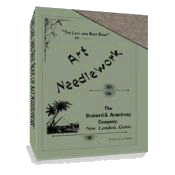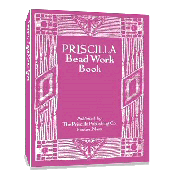All About Chinese Embroidery

Chinese embroidery was a favorite of Victorian women. And who can blame them? The wonderful colors and the unique style always seems to please.
Here is a little about this embroidery as it was written in The Dictionary of Needlework: An Encyclopedia of Artistic, Plain and Fancy Needlework. 1887, by S.F.A. Caulfeild and Blanche C. Saward 1887. It has been edited for use on this site.
Please note that the article was written in present tense, which is not OUR era. Therefore statements made were that of a Victorian mindset, the present dynasty referred to is a past dynasty to us, and the patterns sold for a penny are, to my knowledge, no longer available for that price, if available at all. That said, here is what was written:
Chinese Embroidery
The Chinese appear to have learned the art of embroidery from Persia at a very early date, and became celebrated for their productions, which display an amount of labor and delicacy of execution almost unsurpassed, saved by the Japanese embroideries. But little of ancient needlework now remains, the dampness of the Chinese climate being injurious to the preservation of materials, and the long civil wars proving destructive to much that had escaped the action of the climate; but the ancient designs are continually reproduced with extreme fidelity; the Chinese mind being averse to novelty and change, and preferring what is already pronounced good to any innovations.
Toochow was the ancient seat of Chinese embroidery. At Canton and Nig-po, during the mid to latter 1800’s, a great deal of embroidery was worked, particularly large screens, fan cases, and robes, which were the principal articles in request. Men embroider as well as women, and the patience with which they entirely cover a state robe, curtain, or screen with elaborate needlework, is remarkable.
Under the late, robes embroidered with floss silk and with gold and silver thread were worn much more universally than they are at the present time, as it is now considered sufficient to indicate a Mandarin’s rank by a small square of embroidery containing his device, instead of repeating the same, combined with dragons, ribbons, and flowers, all over the dress, as was common during the Ming dynasty.
Chinese ladies are also now content with embroidery in silk instead of floss about their dresses, and the costly floss and gold embroideries are found more upon screens and actors’ costumes than upon ordinary wearing apparel.
The Chinese embroidered in several ways.
In one method of Chinese Embroidery both sides of the work are the same. This was done by painting the pattern upon transparent material, stretching it and working in Satin Stitch backwards and forwards, so that there was no wrong side.
Another kind is crêpe work, as borders to crêpe shawls. In this, large showy flowers were worked in Long and Feather Stitch, or in Chain Stitch. The beauty of the last-named consists in the dexterity of its execution, the lights and shades of the pattern being shown, not by varying the shades of color, but by working the Chain Stitch open and wide apart for light, and close and thick for dark parts, the effect being further enhanced by the soft tones of the oriental colors.
Feather work, in which real feathers were introduced, is another kind of embroidery they execute; the designs in the parts where the feathers are to be laid are stamped upon metal, to which the feathers are glued, and the rest of the pattern finished in silk work.
Their most famous Chinese embroidery is with floss silk and gold and silver threads. The patterns for these, though numerous, exhibit but little variety, the sacred dragons, various monsters, figures, jars, ribbons, asters, and cherry blossoms, mixed with birds and butterflies, being repeated and accurately copied as to colors in most of the designs. Pattern books for these are sold in China for a penny in the latter 1800s.

Click on image to see more detail.
The figure above is an example of this kind of embroidery. It is taken from the border of a Mandarin’s robe, which is covered from top to bottom with embroidery in floss silk, gold an silver thread, and purse silk, representing dragons, quaint animals, flowers, ribbons, and jars.
It was worked as follows: The foundation material is of dark blue silk, and the dragons are constantly repeated all over it. Make them of gold thread, laid upon the surface and COUCHED down with colored silks. Where the animal has scales, arrange these threads as half curves, but upon the head, feet, claws, and tail make the lines to follow the undulations of the parts they represent. Pad the eyes and make them very prominent, and work with colored floss silk; decorate the mouths with long white moustaches, which are allowed to trail and curl over the background.
The flower shown in the above illustration is taken from the border of the robe; surround every petal with a fine white silk cord, and fill with FRENCH KNOTS in purse silk, color deep crimson, shading the pale silk in centers; make the half-opened flowers of the same colors, work in SATIN STITCH, with leaves of a deep green; work the ribbons in dark blue, where turned under in light blue, or green turned under yellow silk; the outline knot of ribbon with white cord, and fill with crimson French Knots.
Work the animal at the side in red and white, without any intermediate shades.
None of the colors blend imperceptibly into each other; all are sharply defined, and three distinct shades used when any shading is employed, but the greater part of the design is in Satin Stitch worked in one color. The effect is in no way bright and vulgar, as the tints are all subdued and blend together.
A Chinese Embroidery Penwiper

Here is a chance to try your hand at Chinese embroidery. This Chinese Penwiper is a small project that will make a very pretty item for your desk or as a display on a table.
Give this Chinese Penwiper a try.
Return to top of Chinese Embroidery page.
Return to Types of Embroidery page.
The Last and Best Book of Art Needlework
Over 100 pages of authentic Victorian instructions and patterns from 1895!
FREE
Beeton's Book Of Needlework

433 pages!
Sign up for VEAC! Everything you wanted to know about Victorian embroidery, needlework, crafts and more!
Priscilla Bead Work Book
Make Beautiful Victorian Beaded Purses, Jewelry & Accessories - Starting
TODAY!



